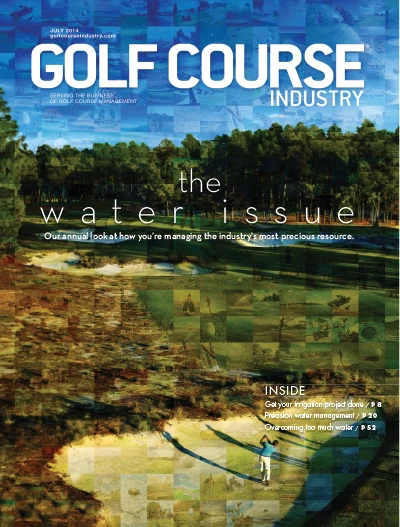I’ve been all over the world visiting golf course superintendents and observing how they’ve applied their smarts and ingenuity to innovate and problem solve.
What has always amazed me the most is how a superintendent or equipment manager can solve a major problem with a seemingly minor modification to an existing golf cart, or create something so useful and mind blowing out of scrap bits of metal, a handful of common parts, and a few oddly sized sheets of plywood.
Necessity is the mother of invention, it’s said, and the following Top 10 reflect just how superintendents, assistants or equipment managers – when they put their minds to it – can solve just about any course-related (and in this case water-related) problem.
1. Hose Reel Trailer
 Rick Tegtmeier, CGCS, director of grounds
Rick Tegtmeier, CGCS, director of grounds
Des Moines Golf Country Club
West Des Moines, Iowa
First featured in May 2010
This trailer built in-house along with a manufactured hose reel that makes the golf maintenance staff much more efficient and makes their jobs much easier. The trailer’s ATV tire, wheel, axle and hub kit; high-impact fenders and stainless-steel hitch parts were acquired from Northern Tool & Equipment. The trailer’s tongue and framework were homemade using 1½-inch square metal tubing. The hose reel holds 100 feet of 1-inch diameter hose while using a Lesco rosette nozzle. A 15-foot, 1-inch diameter hose to connect the hose reel to the quick coupler valve was acquired locally. The material costs were $875 each for the three trailers built, which took about 20 hours each to construct. There is also a 12- volt battery operated hose reel available from Cox Hose Reels.
2. Wetting Agent/Fertigation System
 Barry R. Adams, superintendent
Barry R. Adams, superintendent
Roseburg Country Club
Roseburg, Ore.
First featured in October 2010
This wetting agent canister and fertigation system is used with quick coupler keys and sprinkler head inserts. The sprinkler head connection for the Rain Bird Model 700 has a universal head adaptor, schedule 80 6-inch and 2-inch nipples, a 1-inch faucet valve and a 1-by-¾-inch F & H Rain Bird swivel that costs about $107. A Hypo Filter Wetting Agent Canister, 1¼x ¾ inch (MIP x FHT) fitting, a ¾ inch FPT x ¾ inch FHT fitting, a ¾-inch MHT x ¾-inch MPT fitting and a ¾-inch schedule 80 close nipple had total assembly costs of about $55. The 100-foot, 5/8-inch diameter Fexogen hose, plastic sprinkler head base and ½-inch adjustable brass impact sprinkler cost about $77. The A.M. Leonard-Hozon Siphon Mixer Brass Fertilizer Proportioner attachment costs from $15 to $32.50 and the 5-gallon plastic bucket is less than $5.
This system works great to apply wetting agents and fertigation at the same time or separately using a sprinkler head run time. It also works quite well when hooked-up to a quick coupler valve instead of having an employee hold a hose, as one person can monitor several of these operating at different areas on the course at the same time. Even a gang of portable sprinkler heads can be connected together to cover multiple dry spots. The fertigation system works great during grow-in on small-seeded areas and as needed elsewhere. It took about 1½ hours to assemble all of the parts.
3. The Bazooka
 Lake Bluff Golf Club
Lake Bluff Golf Club
Lake Bluff, Ill.
Rob Foster, director of golf & park maintenance
F irst featured in February 2013
Being prepared well in advance for the annual blowing-out of the irrigation system is paramount. “The Bazooka” is an adapter for hooking-up two air compressors simultaneously to the pump station’s 12-inch diameter discharge pipe that is ready to go every fall. It was designed and built by the superintendent and his staff. It is made mostly of 2-inch diameter galvanized pipes, with multiple shut-off valves, hook-ups for 2-inch and ¾-inch diameter hoses from the 210 & 375 CFM air compressors, respectively, set at about 550 total CFM, where the regulator is set at 55 PSI. The irrigation system is blown-out two complete times and it takes about one-and-half days to do a really good job. It took about two hours to assemble the parts, which cost about $500. It is stored in the pump house.
4. Portable Sprinkler
 Cape Girardeau Country Club
Cape Girardeau Country Club
Giradeau, Mo.
Brad Twidwell, superintendent & general manager
First featured in February 2013
An old 1989 Toro GM 3000 triplex greens mower frame was recycled and used as the base. A 1970s vintage Toro model 405 full-circle brass sprinkler head was attached to the frame where the steel reducer portion was welded to it. A 1-inch galvanized coupling is connected to the sprinkler head and to a 1-inch diameter 90-degree elbow that has a male slip connection where the 1-inch diameter hose is attached with hose clamps. Each 1-inch diameter hose is 100 feet long and is attached to a quick coupler valve. It will not tip over and it covers approximately a 100-foot diameter circle. It took about 45 minutes to assemble mostly from used parts and spray paint cans already in stock. Extra irrigation parts cost about $20. It is primarily used during recent drought conditions.
5. Centralized Hose Rack
 Hermitage Country Club
Hermitage Country Club
Manakin-Sabot, Va.
John Haley, director of golf course operations
Eric D. Spurlock, Manakin Course superintendent
First featured in November 2008
This was designed and built to better organize all of the hoses and watering accessories for quick and easy access at a centralized location at the turf care center. Many sections of hoses can be stored. A wooden box with hinged cover mounted on one end of the post keeps quick couplers, nozzles, fittings, wetting agent canisters organized and close to the hoses. Also, it is great that it is portable so it can be moved wherever needed.
6. Moisture Meter Modification
 Hillcrest Country Club
Hillcrest Country Club
Bartlesville, Okla.
Matt Wilson, superintendent
Steve Ball, equipment technician
First featured in March 2014
This Field Scout TDR-100 (about $735) handheld moisture meter stand was built in-house and saved the club about $300 versus purchasing one welded together as a single unit. The stand was built so the staff did not have to bend-over to take the moisture readings. The handle (and neck) was made using ½ -inch square tubing and it was extended an additional 2 inches on one side to account for the electrical plug coming out of the display unit. The display unit is mounted to the 2-by- 1⁄8-inch metal flat stock with 2-inch wide industrial Velcro. The cord is attached with 4-inch black nylon cable ties on the neck. The probe unit slips into 1¼-by 1⁄8-inch thick flat metal stock block held in place with one ¼-by-1¾-inch long bolt with locking nut. The metal pieces were all welded in place and then painted with Rust-Oleum black hammered paint. It took about two hours to design and build the first stand and another two hours to paint/drying time. The materials cost about $20 for each one. The display and probe units can be easily removed from the stand as-needed.
7. Irrigation Parts & Supplies Mobile Storage
 Palmas Del Mar Country Club
Palmas Del Mar Country Club
Humacao, Puerto Rico
Osvaldo Cruz, director of golf course operations
First featured August 2007
Par Aide Divot Mate Containers were not used on the par 3s any longer so they were recycled by using them to store irrigation parts and supplies. They were mounted onto the back of the EZ-Go Workhorse irrigation technician’s cart by bolting them to the sides of the bed using ½-inch diameter nuts, bolts and locking washers. The container’s hinged top keeps everything dry inside and they hold 4 gallons each. They cost about $48 each when purchased new. It took about one hour of labor time to install all of them.
8. Trailer Turf Modifications
 Aspen Corp. Golf Division
Aspen Corp. Golf Division
Daniels, W.Va.
Donnie Adkins, president
Ronnie Adkins, Vice president
First featured in December 2008
This Pronovost Model 5103S three-sided dump trailer is used during irrigation and drainage piping installations on existing golf courses and has a 10,000-pound capacity. Larger special-order turf tires and wheels, modified tandem axle beams to double their strength, added 4-inch lift to raise the dump body from rubbing on the larger turf tires and the trailer hitch was lowered about 8 inches to compensate for the trailer body being about 12 inches higher than before. Scrap metal was used to pre-fabricate in-house. The cost for labor and materials was about $5,000.
9. Protecting Sprinkler Heads from Aerifier Tines
 Lakewood Country Club
Lakewood Country Club
Rockville, Md.
Chris Ayers, CGCS
Mark McGreevy, assistant superintendent
Larry Baxter, Jr., equipment manager
First featured in November 2006
Each sprinkler head and quick coupler valve (and any other visible irrigation and drainage equipment) is covered with 12-by-12-inch, 16-gauge pieces of steel plate to protect them from fairway aerifier tines. Two 4-by-8-foot, 16-gauge steel sheets ($75) were required to make 32 individual steel plates using a circular saw with a special steel cutting blade. A grinder was then used to smooth out any sharp edges and then they were painted “safety yellow” using a rust-proof paint ($35). There are enough plates for placing them on the next hole after the current one is being aerified. No sprinkler heads have been damaged since using this great idea. It took four to five hours of labor time during the winter off-season.
10. Sink Drain Soil/Moisture Profiler
 Gateway Golf & Country Club
Gateway Golf & Country Club
Fort Myers, Florida
Jim Phelps, Superintendent
First featured in June 2010
A unique soil/moisture probe profiler made out of a 1¼-inch diameter by 12-inch long chromed sink drain extension pipe, with a 1-inch diameter by 16-inch long wooden dowel placed inside, which effectively pushes the soil sample plug through the end of the pipe. This nice size plug provides viewing of the soil, moisture levels, thatch, organic matter and turf canopy much better, and it is much easier to replace the plug than when using a standard size soil probe. Great for checking moisture levels prior to hand or overhead sprinkler watering. An added bonus is the end of the pipe is like a knife blade and it penetrates the dense turf canopy producing a clean, sharp hole. The materials cost about $10 and there was no real labor involved.
Terry Buchen, CGCS, MG, is president of Golf Agronomy International. He’s a 41-year, life member of the GCSAA. He can be reached at 757/561-7777 or terrybuchen@earthlink.net.

Explore the July 2014 Issue
Check out more from this issue and find your next story to read.
Latest from Golf Course Industry
- KemperSports and Touchstone Golf announce partnership
- PBI-Gordon Company hires marketing manager Jared Hoyle
- Mountain Sky Guest Ranch announces bunker enhancement project
- GCSAA names Joshua Tapp director of environmental programs
- AQUA-AID Solutions bolsters Sunshine State presence
- Escalante Golf acquires secluded Illinois course
- Tartan Talks 105: Nathan Crace and Todd Quitno
- Disease Discussion 24: Let the turf talk to you







